
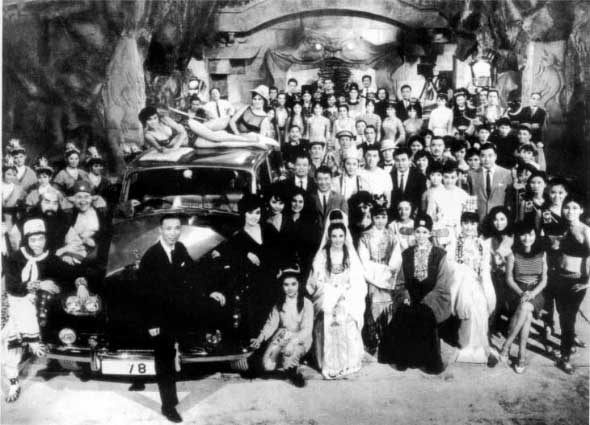


Run Run Shaw and his family had generated extensive wealth since the 1920s from various theatre and production companies spread across South East Asia, but rivals in Hong Kong were competitively ahead of them. So in 1957, Run Run Shaw went to personally oversee production and reinvent the company (Shaw and Sons) for modern times. He realised that this studio was primarily focused on exhibition rather than production and could not possibly compete with larger firms such as MP&GI. So on March 1958, he announced the establishment of a new company called Shaw Brothers and engaged in the construction of a modern Hong Kong film studio (1).
INDUSTRY
In 1961, Shaw Brothers’ studio “Movietown” was completed. To compete with rivals such as MP&GI, Run Run Shaw based his company on the Classical Hollywood mode of producing films where he "introduced a series of reforms to facilitate the implementation of the big studio system, that is, centralisation and systemisation of film production (2)" (Chung, 2003:9). For instance, his actors and staff were given fixed contracts, working on numerous pictures exclusively that allowed them to create and build on their successes at the Hong Kong box office (using director/star combos such as Jimmy Wang Yu and Chang Cheh repeatedly (3)). Through this system, the company was structured as a production line allowing films to come out fast and efficiently with 300 pictures in the company‘s first twelve years (4).

Yet despite mass producing films, each one would have high production values. The film industry in Hong Kong before the major studios arrived was primarily Cantonese cinema which was the dominant language spoken in the area and at the time relied only on the local market as its main source of exhibition. But Shaw Brothers favoured the Mandarin language (5) as it was spoken in other Asian countries such as Singapore and Taiwan and so this would allow them a larger market share internationally. Shaw’s were able to invest more money in their Mandarin films as the returns would be higher than if it were just for a local audience and so this devalued the Cantonese features with their lower production values which could only compete for a smaller market. Because of this, Shaw could comfortably invest HK$800,000 into every feature against the average Cantonese movie budget of about US$20,000 (6).
But Shaw Brothers had a major rival during the 60s that was in competition for the audiences. Before Run Run Shaw arrived in Hong Kong, its future rival MP&GI (later renamed to Cathay) flourished due to its westernised approach to filmmaking. Its manager, Loke Wan-tho adopted a “Fordist style” company similar to Shaw Brothers (featuring a patriarchal power structure (7)). Shaw knew that Loke would be his toughest competitor and made sure that Shaw Brothers would exclusively compete with the films of MP&GI, so "from the start, Shaw Brothers specifically targeted MP&GI and rushed to produce films that had been scheduled by their rival" (Zhang, 2004:168). However Shaw had the advantage since he had moved to Hong Kong to run his company allowing decisions to be made instantly. MP&GI on the other hand were based in Singapore and this caused MP&GI to drop various films just because Shaw Brothers could outpace their production or negotiate better deals with the local Hong Kong talent. As MP&GI's headquarters were in Singapore, the line of communication was longer so decisions took longer to reach Hong Kong while Shaw was right at the top of his hierarchy (8).
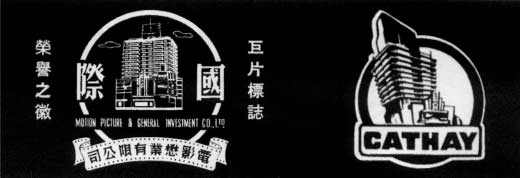
With MP&GI struggling to compete, being outpaced by the efficiency of Shaw Brothers (and further set back by the unfortunate passing of Loke Wan-tho), Shaw’s created a virtual monopoly with no other major competitors since the local studios didn’t have the money to produce films of Shaw Brothers quality or the venues to distribute them such as the cinema chains that Shaw owned. "The professionalism, lavishness, rational management, advanced technology and aggressive marketing enabled Shaw Brothers to dominate the Hong Kong (and Southeast Asia) cinema" (Fu, 2000:79).
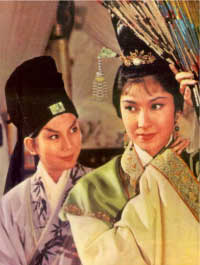
To consolidate its market, Shaw Brothers capitalised on generic trends and it was the martial arts picture that quickly became the most popular form of entertainment in Hong Kong. Shaw Brothers had originally found fame with their lavish wenyi melodramas and huangmei diao musical films such as The Kingdom and the Beauty (1959) and The Love Eterne (1963). Yet it is stated that “the huangmei diao musical was a monotonous form” (Law, 2000:131) which recycled old Chinese legends and tales so the audience desired new energy in their films. It was the wuxia (9) film which quickly gained the audience’s interest and when this genre proved successful, Shaw Brothers with their production line techniques quickly adapted to the trend with an increasing percentage of the studios assets and focus used on the “swordsplay” genre in particular (10) as their most important sector calling it the beginning of “the wuxia century“.
AESTHETICS
Two directors in particular represent the dominance of the Shaw’s wuxia genre and demonstrate the evolving martial arts film in the 1960s. The first is King Hu whose most famous work for the studio was Come Drink With Me (1965) which was Shaw Brothers first major wuxia box office hit and with this success led to a flood of sword fighting films with the genre becoming Shaw‘s most predominant. King Hu managed to fuse both Western and Eastern styles of filmmaking to create his own innovative approach. He had studied Peking Opera and incorporated this style into his films where "King Hu developed a unique style of motion and a film aesthetic grounded in traditional Chinese painting, literature and theatre" (Zhang, 2004:178). King Hu brought visual sophistication and energy to the new-style martial arts picture, for example his fighting scenes are synchronised with a percussive beat (drums and gongs) reminiscent of Peking Opera aesthetics. But to make the fights seem even more spectacular, King Hu fused these Eastern concepts of dance with Western forms of filmmaking.

King Hu had studied American styles of editing where "using Chinese cinema as a base, he endeavoured to include Western style of thinking and technology" (Zhang, 1999:17). King Hu was not an expert of fighting styles, yet his fights incorporate fast and fluid movements and to achieve this just like constructive editing, he broke the scenes down and called this technique “The Glimpse“. For example "Hu also frequently stages, shoots, and cuts his action so that it becomes too quick, too distant, or too sidelong for us to register fully" (Bordwell, 2000b:118). He would put in just enough of a comprehensive shot to make the audience think they have seen something spectacular but it is so quick to register that it plays with the audience’s imagination. These techniques allowed films such as Come Drink With Me to be huge successes as King Hu had created these magnificent martial arts heroes through tricks of the camera without using special effects such as wirework that can cheapen the action (11). This style was extremely successful because early martial arts films were shot statically. The camera would be motionless with long uncut takes, distanced from the action where two men perhaps would improvise a fight consistently for a few minutes (12) while King Hu used dance choreographers to plan the stylised action. It was the beginning of a progression into realism with directors appreciating the value of the fight scene. King Hu had managed to incorporate a sense of fantasy and energy in his films along with sophistication to the genre, which allowed it to become popular, but over time, the audiences wanted more realistic action aesthetics and this is where the second director arrived (13).
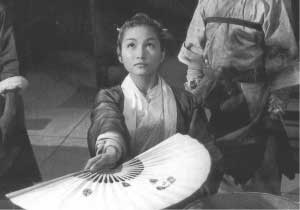
Chang Cheh was Shaw Brother‘s most successful wuxia director with his film The One Armed Swordsman (1967) being the first swordsplay film to make HK$1 million at the box office (14). Just like King Hu, Chang Cheh‘s "combat scenes seem strongly influenced by Japanese techniques" (Bordwell, 2000b:115). Shaw Brothers expansion into the wuxia genre could perhaps be seen in relation to the popularity of the Japanese chanbara films flooding into the Hong Kong market such as Yojimbo (Kurosawa:1962) which became popular through their violence and realistic fight choreography (along with the strong leading man such as Zatoichi). Run Run Shaw was aware of the trend in Japan and the USA’s action cinema and influenced his directors by “scheduling mandatory screenings of Japanese and yakuza films for his staff” (Ho, 2000:115) to try and influence their style through the popular and more advanced Japanese cinema. Shaw had been influenced to such a degree from Japanese filmmakers that not only did he hire directors and technicians such as director Inoue Umetsugu, but he also sent his staff to Japan to learn various filmmaking techniques such as efficient set design and camera work. Shaw realised he could make money off this style of film and this helped boost the investment in Shaw’s wuxia films. For example Chang Cheh borrowed techniques used in chanbara (15) films such as Yojimbo featuring tracking shot‘s which follow the combat as a lone fighter proceeds to kill his opponents one by one and prolonged death sequences. Instead of the peaceful long shots that played a part in the Wong Fei-hung (Various:1955) series from the 1950s, Chang’s films were chaotic and full of quick cuts, handicams and fast zooms adding to the energy and innovation in the martial arts genre.

As mentioned earlier, realism was what the audience wanted in these martial arts films and Chang Cheh exploited this. Along with technological advances, his films used other various techniques to make them seem more “real”. Firstly Chang Cheh’s films used fake blood to make the fights appear more visceral instead of King Hu’s bloodless combat. Also weapon props were replicas made from metal, heightening the realism but most importantly, "the 1950s kung-fu films had simply allowed actors to improvise their fights, but now the martial-arts instructor became an important crew member" (Bordwell, 2000a:206). Chang Cheh was aware that the 1950s martial arts could never satisfy the tastes of the progressive 1960s audience due to its stilted combat and even King Hu’s action was more focused on dance traditions. So Chang Cheh used trained martial artists to choreograph the fights where Shaw‘s promotion stated that “the fake, fantastical and theatrical fighting and so-called special effects of the past will be replaced by realistic action and fighting that immediately decides life or death” (Ho, 2003:115). Choreographers enabled untrained actors to mimic actual martial arts moves and so the action began to move away from the style of dance choreography associated with Peking Opera to grittier, livelier and bloody aesthetic, reflective of the mood of the audience.
REPRESENTATION
When Shaw Brothers had started production and were competing with their rivals MP&GI, it was their huangmei film with high end production values which set them apart and allowed them to dominate the market. But with changing times and audiences, the studio’s focus as it began moving into the 1970s altered from a female focused studio into one that was more male orientated (in both audience and stars). Shaw Brothers and Chang Cheh specifically tried to cater for the audience of 1960s Hong Kong by creating heroes and plots reflective of the times and mood of the 60s, mentioned earlier by incorporating a sense of realism into the aesthetics. This can be pinpointed to 1967 with the Hong Kong Star Ferry riots (16). Hong Kong became a state of chaos and rebellion where violence and unrest went on for seven months. Young people in particular were challenging dominant patriarchs and rebelling against the system and the turbulence led to changes in entertainment. The audience needed escapism from the anarchy in reality but the current trends in romantic musicals could not possibly satisfy this new rebellious audience that needed a hero to represent these uncertain times (17). The trouble was the male characters of the 1950s were often scholarly and effete. The audience could see reflected in the films "characters to symbolise China's subjugated and weak condition which prevailed for about a hundred years from the Opium Wars to 1949" (Teo, 1997:77). So there needed to be a change from the weak (such as the male lead of The Love Eterne (Han:1963)) or one dimensional heroes (such as Wong Fei-hung who critics claim lacked individuality or emotions) and Chang Cheh was the director to create the new heroic male version (18) who would embody the colony’s newly acquired self confidence and individuality rather than the older conservative Confucian values represented by Wong Fei-hung. "Young audiences were captivated, seeing the new trend towards violence as a purging of repressed emotions" (Teo, 1997:100).
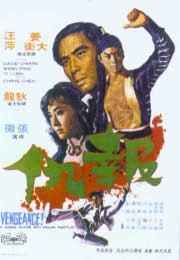
Chang Cheh’s heroes suffer from living in their violent worlds and are usually self-reliant individualist’s (19). The character Fang Gang in The One Armed Swordsman for example, is a flawed hero (handicapped with one arm) that through sheer determination and the will to rise up against his violent surroundings turns his weakness into strength and makes his one arm powerful enough to defeat all of the villains (20). He starts the film off as a working class man who is not respected by his classmates due to his poor background but eventually rises to become respected and powerful (something which the young working class audience would associate with and so Shaw Brothers were able to exploit this as a character trait in their wuxia films). But occasionally even the villains overwhelm the hero and in these circumstances the hero dies a tragic death (unheard of before Chang Cheh‘s films). At the end of Vengeance! (Chang:1970), the main character battles hordes of enemies who easily outnumber him. But even with blood pouring from his wounds (heightening Chang‘s realistic aesthetic) and despite finding it difficult to stand, he fights to the bitter end until eventually dying, but not before vanquishing the villains so that he can rest in peace. These heroes are willing to sacrifice themselves for their “brothers” and for a better world (with slow motion shots to make their sacrifice more poignant). This conclusion could be accepted during the 1960s, as there was a lack of moral standards within the chaotic society. With themes of brotherhood and the betrayal of the patriarchy is a clear reflection of how Shaw Brothers could mass produce films which spoke directly to the Hong Kong audience and shows how in the late 1960s, they were the top of the Hong Kong film industry.
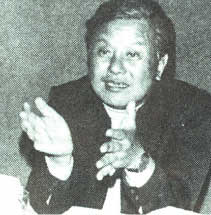
The aesthetics and representation of early Shaw
Brothers films are due to the fact that "Zhang also said that violence
was portrayed in films only because violence existed in society" (Teo,
2003:152). But as the violent wuxia hero was a portrayal of the feelings
of late 1960s Hong Kong, could it still be popular in the 1970s as the
violence in Hong Kong became subdued and economic stability arrived?…
ENDNOTES FOR CHAPTER 1
(1) Information from The Shaw Screen (Chung, 2000:7)
(2) For example, Shaw scheduled weekly production and script meetings to ensure every stage of filmmaking was systemised and that everything met his high standard of approval. Shaw Brothers films were practically Run Run Shaw's films exclusively (every Shaw Brothers film has his name as a producing credit).
(3) For example the first time Chang Cheh and Jimmy Wang Yu worked together was on Temple of the Red Lotus (1965) but subsequently worked together again on Tiger Boy (1966), Magnificent Trio (1966), One Armed Swordsman (1967), The Trail of the Broken Blade (1967), The Assassin (1967), The Golden Swallow (1968) and many others. Shaw Brothers realised that once a combination had success, they would repeatedly use them to make a “safe” profit.
(4) Information from Planet Hong Kong (Bordwell, 2000a:63)
(5) 90% of Hong Kong citizens speak Cantonese instead of Mandarin (Information from Cinema of Hong Kong (Desser, 2000:78). Mandarin is spoken by mainland Chinese.
(6) Figure from Planet Hong Kong (Bordwell, 2000a:62) (US$20,000 is around HK$100,000)
(7) Information from The Shaw Screen (Chung, 2003:8 )
(8) His business was almost like an empire with Run Run Shaw firmly in control. His actors and directors lived in apartments on his 65,000 square feet of land and he even had his own police force and bank for his staff.
(9) Wuxia is roughly translated as “Sword-fighting” (Cinema of Hong Kong, 2000: 97)
(10) Shaw Brothers is known primarily for their martial arts films despite making other popular genre films like Hong Kong Nocturne (Umeji: 1966), a musical but "in 1968, Shaws released 12 wuxia films out of a total of 29. In 1969, 17 out of 35. In 1972 26 out of 37" (Law, 2003:138) showing that the wuxia film was priority for a long period.
(11) This filmmaking was related to constructive editing and enabled King Hu to portray spectacular feats without using acrobatics. With constructive editing, the action is broken down into stages for example a character would jump up into the air in the first shot. The second shot would be the man flying against the background of the sky and the final shot would be the man landing on a higher platform.
(12) Also the wuxia films of the 50s such as Buddha’s Palm featured magical feats such as fireballs. The wave of swordsplay films led by King Hu featured less magic though still exaggerated moves such as vaulting.
(13) King Hu had started as an actor with Shaw Brothers but in the mid 1960s he had begun co-directing work with Li-Han-hsiang with various huangmei diao films before eventually making the move to become a full time director. The success of Come Drink With Me was marred by the fact that Shaw was not happy with Hu's filmmaking methods. Shaw Brothers was a company built on the principles of production line techniques so that films should be made fast and efficiently. Yet King Hu took his time with his filmmaking and this naturally didn't fit with the structure of Run Run Shaw's studio so it was no surprise that they parted ways after Come Drink With Me, while prolific directors like Chang Cheh lasted for a long period with the company.
(14) Information from Chinese National Cinema (Zhang, 2004:177)
(15) Chanbara (a.k.a. Chambara) is the name for the Japanese Samurai Action film
(16) Information from http://www.britains-smallwars.com/RRGP/HongKong.htm
(17) Which also links with International cinema with starts like Steve McQueen, Sean Connery and Toshiro Mifune dominating screens. Just as Run Run Shaw had observed the trends in popularity of the chanbara genre, he was also aware of the youth generations influence in cinema, especially in America. "While Chang and Shaws' switch to a youth-orientated cinema was a response to a larger movement that originated from the West, the swing from a female sensibility to one of male took place at about the same time as -even ahead of- a similar trend in Hollywood" (Ho, 2003:118). Male characters such as James Dean and James Bond represented the fine line between good and bad with anti heroes popular in Chambara and Spaghetti westerns. But while these characters rebel against social conventions, it is Chang Cheh’s characters who must suffer if they are to succeed.
(18) Chang Cheh‘s heroes were predominantly male because "Zhang considered that the male image had suffered for nearly twenty years because of the long reign of female stars in traditional soft genres such as the wenyi (literary art) and melodramas....The female dominance had come about because of the conservatism of the female audience that made up the majority of cinema-goers" (Teo, 2003:148). It was Chang’s opinion that this situation was as it was because conservative women could not openly admit to liking male stars (so females watched females). Chang Cheh wanted to reform this by creating a hero that both men and women could enjoy through the strong male hero character.
(19) Chang Cheh’s often favoured themes of individuality but there were also strong themes of brotherhood where men would sacrifice themselves for other heroic men out of loyalty, respect and honour. Chang Cheh even coined a term for this brotherhood, calling it “yang gang”.
(20) The villains in Chang Cheh’s films such as
The
One Armed Swordsman or Golden Swallow are clearly
representational of the patriarchy which the 1960s youth were challenging
in reality. The villains of these films are overtly corrupted and devious
who can only defeat the heroes through tricking them such as the villain
of The New One Armed Swordsman using his former status as
a hero to betray the martial arts world. It is only when the younger noble
heroes arrive that the corrupted older hero/villain representational of
the old establishment is punished and replaced.